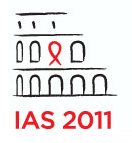Daily oral tenofovir/FTC PrEP reduces heterosexual transmission by 63% in the TDF2 study
1 August 2011. Related: Conference reports, Antiretrovirals, HIV prevention and transmission, IAS 6th Rome 2011.
 Simon Collins, HIV i-Base
Simon Collins, HIV i-Base
Results from the double-blind placebo-controlled TDF2 study presented in an oral presentation in Rome provided additional supportive data for the benefit of daily oral tenofovir/FTC (Truvada) to reduce sexual heterosexual transmission. [1]
While the iPrEX study first reported a strongly protective impact in high risk MSM, the lack of protection in the FemPrEP study earlier this year has still to be explained. [2, 3]
TDF2 randomised 1200 sexually active HIV-negative adults (age 18-49: approximately 90% were between 21-29 years) and followed them for a year. Over 90% of participants were single with only 3% having low educations (primary or less) with >70% having secondary and >20% having post-secondary education. HIV testing was monthly and as with all prevention studies, intensive counselling on safer sex and free condom distribution was provided throughout the study. An indication of the background risk in this population is that 16% of people failing screening (197/2533) were excluded due to already being HIV-positive and 20% due to not being sexually active.
A slightly higher percentage of people in the active vs placebo arm (34% vs 31%) did not complete the study due to loss to follow-up, withdrawal of consent, relocations or other reason. The study had a good gender balance with 45% women.
With 33 seroconversions, primary efficacy results reported a 63% reduced risk of transmission with Truvada based on 9 new infections in the active arm compared to 24 in placebo group (difference 62%: 95%CI 21.5 to 83.4, p=0.0133).
When restricting the analysis (post hoc) to infections within 4 weeks of a study visit (ie where the monthly visit schedule was being followed and the participant was under a prescription period) the association became stronger. Out of 23 seroconversions, 4 occurred in the active arm and 19 in the placebo group with 78% protection efficacy (95% CI 41.2 to 93.6, p=0.0053).
Although it was emphasised that the study was underpowered to draw any conclusion by gender, in an ITT analysis (33 cases) the intervention appeared protective in men (p=0.026) but not women (p=0.107) and in the observed results (23 cases) the protection was seen on women (p=0.021) but not men (p=0.065). Whilst interesting to see if a gender effect can shed light on the results from FemPREP, this will need to come from larger study numbers.
Resistance developed in one person enrolled in the active arm whose acute HIV infection was undiagnosed with K65R, M184V and A62V conferring nucleoside cross resistance. The person has achieved viral suppression after starting treatment with AZT/3TC/lopinavir/ritonavir. One person in the placebo group had low-level K65R suggesting an infection with drug resistant HIV.
Side effects were commonly reported in both arms, usually mild, with nausea (19% vs 7%, p=0.0001) and vomiting (11% vs 7%, p=0.005) occurring more significantly in the active arm compared to the placebo arm, but resolving within the first month. There were no differences in laboratory abnormalities with one case of elevated creatinine in the active group that resolved when treatment was stopped.
References
- Thigpen MC et al. Daily oral antiretroviral use for the prevention of HIV infection in heterosexually active young adults in Botswana: results from the TDF2 study. 6th IAS Conference on HIV Pathogenesis, Treatment and Prevention, 17-20 July 2011, Rome. Oral abstract WELBC01. Webcast.
- Grant RM et al. Preexposure chemoprophylaxis for HIV prevention in men who have sex with men. NEJM. 23 November 2010 (10.1056/NEJMoa1011205). Free full access.
- FHI statement on the FEM-PrEP HIV prevention study: FHI to initiate orderly closure of FEM-PrEP. (18 April 2011).

